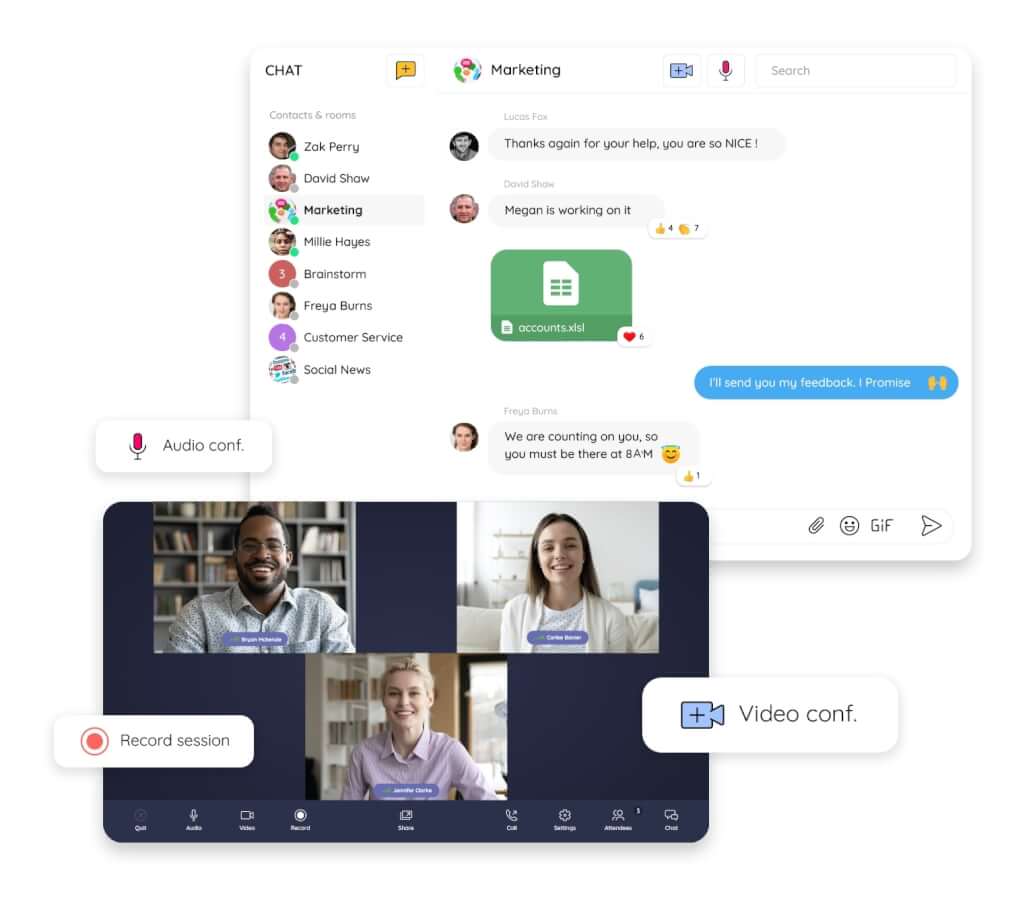Remote work has dramatically increased over the past few years—and the number of people working remotely is only expected to grow in coming years. For example, the Economist Report: Future Workforce report from freelance work platform Upwork projected that, by 2025, 36.2 million Americans will be working remotely—16.8 million more workers than before the COVID-19 pandemic.
And with remote work becoming more and more normalized, it’s more important than ever for leaders to find ways to effectively collaborate with their team members—and for those team members to more effectively collaborate with each other—no matter where they may be working.
But how, exactly, do you do that? Let’s take a look at four key tips for more effective remote team collaboration:
1. Prioritize communication
By definition, people working remotely are working in different locations—sometimes in different cities, countries, or time zones. And, as such, remote teams don’t have the luxury of sticking their head into their supervisor or co-worker’s office to ask a quick question. Not only are they not in the same office space as their team, they may not even be in the same country.
Effective and clear communication is always an important part of empowering better team collaboration. But prioritizing communication is even more important for remote team collaboration, when teams may be working asynchronously and across different time zones.
Also read: [Ebook] Future of Work: Make Way for Hybrid Work!
How you communicate with your remote team will dictate, in large part, how successful they are—both individually and collectively. Some things to keep in mind to ensure effective communication (and, as a result, effective collaboration) with remote teams include:
- Set clear communication guidelines. In order for remote teams to communicate effectively, they need clear guidelines around communication. Make sure to clearly outline for your employees how to best communicate with their team members (for example, if they have a question on a project, should they send the question in a chat—or post it to your project management platform?). You’ll also want to outline the “communication chain of command” for if and when they face a problem (for example, if they run into a project-related issue, who do they need to report the issue to—and who can they reach out to and get real-time support?).
- Be extra clear when giving directions. As mentioned, oftentimes, remote teams work asynchronously. If they have a question on a task or assignment, they won’t always be able to ask that question in real time—which can cause productivity to halt. That’s why it’s important to give incredibly clear directions when assigning tasks. Include any supporting information or media that might make your directions more clear (for example, a video documenting how you’d like a certain task completed). Remember—when it comes to giving directions to remote teams, there’s no such thing as too much information or detail. If you feel like you’re over-explaining things, chances are, you’re on track.
- Encourage team members to communicate often. The more remote team members communicate with each other, the better they’ll communicate—so encourage them to communicate often, both in real time (for example, by scheduling one-on-one and/or team video chats) and asynchronously (for example, by sending emails or video/chat messages).
Bottom line? The better and more clearly remote teams communicate, the better they’ll be able to collaborate—so, if you want to empower more effective remote team collaboration, make sure communication is at the top of your priority list.
Also read: How to improve internal communication in your company
2. Make the most out of meetings
Meetings are a must for most remote teams. Because you’re not sharing physical space, it’s important to meet—whether to update the team on the status of a project, work through a problem together in real time, or spend time socializing.
But not all meetings are created equal—and if you want your remote team to collaborate with each other, it’s important to make the most of meetings.
So how, exactly, do you do that? Some things to keep in mind to maximize your meetings’ effectiveness—and empower better collaboration and work from your remote team—include:
- Only schedule meetings when they’re necessary. Many remote workers feel like the majority of their meetings are a waste of time. For example, according to a survey from SurveyMonkey, a whopping 74 percent of employees said that, after attending a virtual meeting, they find themselves thinking “this meeting could have been an email” at least some of the time. And it’s not just a waste for employees; a recent report from Otter.ai and organizational psychologist Dr. Steven G. Rogelberg found that organizations could be wasting as much as $100 million dollars on unnecessary meetings each year! Before you schedule a meeting, make sure it’s actually necessary; your team (and your budget) will thank you.
- Keep meetings on topic and within a reasonable time frame. If you decide a meeting is necessary, it’s important to respect your team’s time. Send out an agenda to all team members prior to the meeting that outlines what you’ll be discussing. Then, when the meeting takes place, make sure to keep discussions on topic—and to keep the meeting to a reasonable time frame.
- Record meetings. When you’re working with a remote team, not everyone may be able to attend in real time, particularly if they’re working in a different time zone. Make sure to record your meetings and send them out to your entire team afterwards; that way, every employee understands what was discussed—which will enable them to work better together.
- Send out action items after the meeting. After the meeting, make sure to send out clear action items to every team member that outlines their tasks, who they’ll be collaborating with to complete those tasks, and any additional information they need to complete the tasks successfully.
In most cases, meetings are a must to ensure that your team has the support and information they need to collaborate more effectively. But just remember to make your meetings as streamlined and efficient as possible. That way, your team has the time they need to collaborate with their colleagues and get work done (instead of spending the bulk of their working hours in meetings).
Also read: The Right Way to Run Hybrid Meetings by Toptal
3. Foster strong relationships with team members
One of the foundations of effective collaboration, whether working together in person or remotely, is relationships. When employees feel like they have a solid, trusting relationship with their colleagues, they collaborate more effectively.
Which is why, if you want to enable more effective team collaboration, you need to help foster those strong relationships with your remote team members.
There are a variety of ways to foster better relationships with your remote team members, including:
- Carve out time for team members to get to know each other. Because remote teams aren’t working in the same space, there aren’t opportunities for them to spontaneously connect and chat—for example, in the company kitchen or by the water cooler. That’s why, as a leader, if you want them to have stronger relationships? You need to create those opportunities. If you have team members that are going to be collaborating on a project, set up time for them to connect over video chat and get to know each other. If you want to foster stronger relationships across your entire team, host weekly team events, like a virtual game night, to give everyone the opportunity to socialize. The better your team gets to know each other, the more they will trust each other and the better they’ll work together—so make sure to be intentional in creating space for them to get to know each other.
- Connect on things other than work. In addition to creating opportunities for your team to connect, you should also try to create opportunities for them to connect about things other than work. For example, you might start a chat channel for employees to share pictures of their pets or discuss their favorite TV show. Again, this can create a more personal connection that strengthens relationships and bonds your team together—all of which will enable better collaboration.
- Create a work environment that values openness and honesty. Trust is an important part of any relationship—including relationships within your remote team. That’s why building a work environment where people feel they can speak openly and honestly is a must. And the way to do that? Lead by example. If a problem arises, address it openly. Encourage respectful feedback. Reward remote team members when they share honestly and openly. That kind of environment fosters trust—and that trust fosters better relationships and better remote team collaboration.
4. Use the right tools
The tips we discussed so far will go a long way in empowering better remote team collaboration. But arguably the most important thing you need to give your remote team in order for them to collaborate successfully?
The right tools.
Talkspirit is an all-in-one work platform that empowers remote teams to do their best work. Talkspirit has all the features remote teams need to more effectively collaborate, including video conferencing; team and one-on-one chat; a project management platform; an internal drive that allows employees to collaborate on documents, spreadsheets, and slides in real time; knowledge management and sharing tools, and much more.

If you want to give your team the tools they need to collaborate more effectively—no matter where they’re working? Talkspirit can help.
–
By Deanna de Bara



